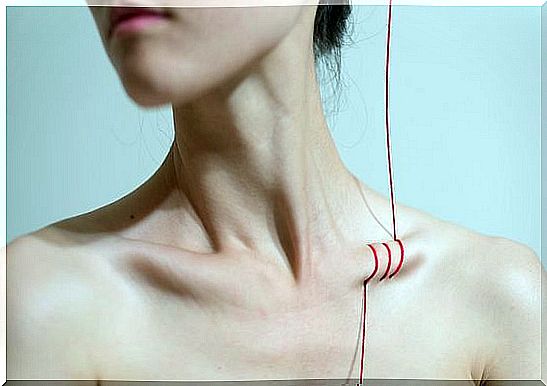Self-harm: What’s Behind This Behavior?

A razor, scissors, or even your fingernails can be used to inflict pain on yourself. These self-harm are for many the escape route from emotional pain. A way to fill the void. But, above all, they are also the translation of a poorly managed mental illness.
The first question that comes to mind when we see those marks, some recent but others attesting to the chronicity of a terrible self-injurious practice is why . Why would someone intentionally want to hurt themselves? Sometimes they are cuts, other times they are burns, and sometimes it is the result of scratching in order to produce a wound.
The psychopathology behind self-harm
The answer to this question is complex. In the first place, because, despite the fact that a large part of the population affected with this disorder are young patients, adults also show it much more than we think at first. At the same time, we cannot ignore a growing and alarming phenomenon either. The impact that self-harm has on social media. In addition to the great contagion power they have on adolescents.
Furthermore, in the fifth edition of the “Diagnostic and Statistical Manual of Mental Disorders” self-harm is considered a disorder with its own entity. That is, with its own origin, course, evolution and symptoms. Of course, taking into account that it can occur in comorbidity with other disorders. Like those of mood, anxiety, food, etc.
For their part, González, RB, & Álvarez, BG (2012) tell us that in the American Psychiatric Association, we consider the “ non-suicidal disorder due to self-harm ”. And he defines it as a strategy where pain serves as catharsis to alleviate negative emotions. Like, for example, the feeling of loneliness, emptiness, isolation. Also, to distract attention from other problems, to decrease feelings of anger. Or, on the contrary, release tension or control certain kinds of thoughts.

Self-harm, the wrong way to escape emotional pain
Something that many experts question about the clinical definition that has been given to this disorder is whether we are really dealing with non-suicidal behavior. It is known, for example, that between 50 and 70% of people who injure themselves, have attempted or will attempt suicide at some point in their life cycle. Perhaps the end in itself of these cuts, of these burns or lacerations, is not to kill oneself, it is clear, but behind this behavior there is a thought and a psychological discomfort that at some point, can have a bad drift.
We know, however, that each case is unique, that each person has their own and exceptional characteristics, but we sensed first of all that self-harm is the tip of the iceberg, they are just the roof of an underground and increasingly intense social phenomenon. which, we should all be more sensitive. The authorities and social organizations, for their part, should also be more attentive and more interested in finding out what is behind all this.

A way to avoid feeling
“When I do the cut, the stress and bad vibes end, then I relax . ” This phrase is the most repeated by adolescents between 12 and 18 years old who practice cutting or self-harm. This form of self-sabotage and self-destruction is a poor adaptation to stress or life’s challenges. And whether we like it or not, it is almost the same behavior of an addict who seeks to consume in order to “forget.”
Although it is true that these wounds are only epidermal cuts and that these young people – for the most part – do not present any borderline personality disorder, many of them do present emotional, relational, school problems, low self-esteem and a clear rejection to your body image.
On the other hand, although there are professionals who think that many times what there is is a way to “attract attention” or to show others the internal discomfort, it can be said that we are facing a much deeper problem and that, as we have pointed out, it also affects the adult population.
How to address self-injurious behaviors
Marcos is 56 years old. He is a professional with a very stressful work life and something very specific draws attention to him: in summer he always wears long sleeves, he takes great care that the button on his wrist never comes off. In the event that the sleeves of his shirt were rolled up at any time, a whole map of horizontal wounds, old marks and some new ones would be revealed.
Marcos is any example of a good part of the adult population. In fact, according to the Universities of Oxford, Manchester and Leeds, for every 100,000 inhabitants there are 65 adults who self-harm . This data is of great relevance, because it has also been shown that the risk of suicide is very high in these cases. If we now ask ourselves what is behind these behaviors, the answer is simple:
- Intense and persistent negative emotions
- High self-criticism
- A great difficulty when it comes to expressing and managing your own emotions.

What’s behind self-harm
The approach to self-harm disorder involves first knowing what is behind this behavior. There may be hidden disorders (eating disorders, depression, obsessive-compulsive disorder, anxiety disorders …). They are realities that only professionals can determine.
On many occasions hospital admission is recommended. However, this option should be the last way. Especially when suicidal behaviors or thoughts already appear. Cognitive-behavioral therapy is effective in these cases. Reduces both self-harm and suicidal cognitions and symptoms of depression and anxiety.
On the other hand, family therapies, group dynamics, therapies based on mindfulness or even dialectical behavioral therapy, help to tolerate anguish and frustration. Also, to regulate emotions and improve relationships with others. Therefore, they are usually very positive approaches when addressing the issue of self-harm. Let us therefore look for more useful, sensitive and reasonable solutions to the pain of life.








